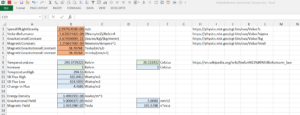I wrote this yesterday, and then realized that if global climate change increases the global temperature by 1 degree then that will change the readings at all accelerometer sites. But the (word that starts with i) at NASA and other places don’t give you the absolute temperature time series, only the change. But the impact depends on the absolute value of the temperature in Kelvin. A change of one degree Kelvin from zero Celsius is NOT the same as a one degree change from 20 Celsius. The scale depends on the Stefan-Boltzmann relation and that is SigmaSB * ((T+1)^4 – (T)^4)
A two minute calculation might take a long time because there seems to be no standard global average temperature. But, if my approach is correct (it is), then we can use the sun and moon vector Newtonian gravitational acceleration signal to calibrate all the gravimeters, then use that to set the level for the radiation field (temperature field over and inside the whole earth) as the base. So the JPL solar system ephemeris becomes the core and groups on the outside looking back to the solar system for a reference, and groups on the inside looking outward can have a stable dataset and services to link all gravitational networks.
Since the National Geospatial-Intelligence Agency wants a stable method for magnetic location (“position and orientation”, the magnetic networks can be included and the compass orientation updated since the magnetic field and gravitational field sensors are coupled and can be inter-calibrated on common standards.
Finally, at https://www.ncdc.noaa.gov/sotc/global/202104 there is ” the 20th century average of 13.7°C (56.7°F)” that is 286.85 Kelvin.
So a 1 degree difference from there mean a global shift in all the gravimeter noise readings by 5.487 nm/s^2 and a shift in the magnetic noise levels by 212.4 nanoTesla. And a shift in the electric field by 8.2217 microVolts/meter.
I am simply using the energy density of the fields in vacuum as a reference. If the whole temperature field of the atmosphere and sky above a gravitational sensor changes, so does the energy density of the electromagnetic and gravitational fields at that location. As I see it, the size distribution of the fluctuations in the field varies as you are talking about “gravity” (very tiny picometers and femtometers), “electromagnetism” and “magnetism” (micrometers and nanometers). But it is just one field. It is the stuff that makes up the vacuum. I think it has many sizes of things, each with their own unique character, properties and values. But they share “energy density”, “acceleration field”, “velocity”, “number density” and many other things.
Shawn,
I wrote about the temperature gravity connection, then calculated the theoretical value expected because the gravitational energy density and the temperature energy density are part of the same field.
They used: −5 (nm/s2)/∘C — so they are getting drift with local temperature. That is fairly easy, just measure and record the temperature and figure it out later. Measure the atmospheric pressure.
The “exact” value for 20 Celsius is a bit higher = sqrt(8*pi*G*Delta) = 5.6688 nm/s2
Where Delta is StefanBoltzman * ((T+1)^4 – T^4) where T is the temperature in Kelvin and a 1 degree difference.
So it depends on the ambient temperature and their gravimeter calibrations and corrections.
it is not hard to do this, just tedious. I have had 40 years to sort it out. But no easy way to share what I have learned.
To get an exact value of 5 the temperature needs to be 20.222922 Celsius.
The equivalent magnetic field is 193.54 nanoTesla.
The equivalent gravitational acceleration field is 5.000 nm/s2
I made a spreadsheet for you in case you are interested.
If you can get a week of data from them for the instrument at a known location, I can show you what the sun moon signal should look like. They would match that signal exactly, then everything else is local. It clearly separates solar and lunar gravitational effects from earth based effects. And it ties to JPL solar system ephemeris which will be more and more important in the future.
Richard Collins, Director, The Internet Foundation
